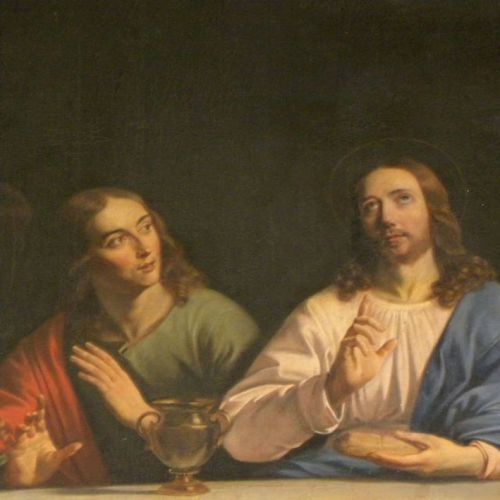Lazarus, Mary Magdalene's Brother
Lazarus the Beloved Disciple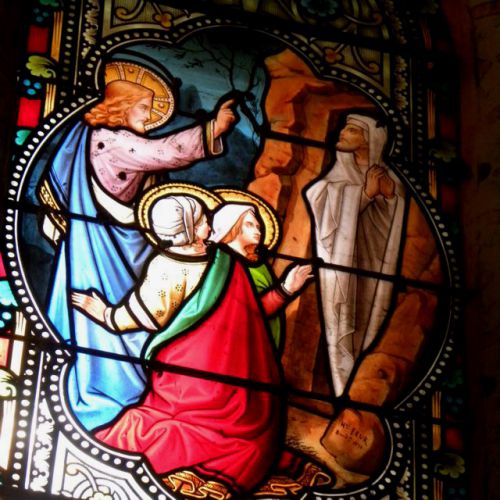 Come out Lazarus! A conventional representation in Rennes-le-Chateau church.
Come out Lazarus! A conventional representation in Rennes-le-Chateau church.
In various parts of the New Testament are mentions of a "beloved disciple" and I am sure this is the brother of Mary Magdalene, Lazarus. Mary and Martha lived with their brother Lazarus at the house of their father, Simon the Pharisee, in Bethany, less than two miles from Jerusalem, a walled town much smaller than it is today.
Described in the Bible is an incident "at the house of Simon the Pharisee" in which Mary Magdalene either washed Jesus's feet with her hair or else anointed him with oil. If you compare the slightly different accounts in all four gospels, it seems that there were two incidents, one at the beginning to Jesus's ministry and another not long before he was crucified. By the last account, in St. John's Gospel, 12,1, the house has become the "house of Lazarus", which implies that their father Simon had died.
There was never any mention of a mother and it seems that Martha took on the role of mother while Mary Magdalene had better things to occupy her; it could be that she was undergoing some sort of religious training.
And so was Lazarus. Scholarly writing confirms this. Passover Plot author Hugh J. Schonfield imagined the beloved disciple to be a highly placed priest in the Temple and unavailable to follow Jesus in his ministry in the north, that is, around Galilee. The British scholar Richard Bauckham reaches the similar conclusion that the beloved disciple, who also authored the gospel attributed to John, was probably a sophisticated member of the "high priestly family clan" - that is, Simon was involved too before he died.
The story of Lazarus being raised from the dead in the Bible is often thought by many church people to prove Jesus was such a powerful God he could bring dead people back to life. But if Jesus could bring dead people to life, why didn't he do it more often and why can't we all live forever? Some would say we do - symbolically.
This story was symbolic or was maybe what many think of as a religious ceremony or event, a metaphorical tale about "raising someone to consciousness" - a religious ceremony leading to spiritual enlightenment. Modern psychic, clairvoyant or spiritual people think so too.
A friend wrote to me; Mary Magdalene used caves to perform initiations/religious ceremonies. The only reasons that caves were used for these was so that they would not be disturbed. This was especially important when someone was undergoing the death initiation as taught in the Isis mystery schools, where such a deep trance was induced it appeared that the person had died. This is what I think happened to Lazarus in the New Testament. He was doing a ritual which required his spirit to temporarily leave his body.
I did a little bit of this in shamanic training, where we had to achieve a trance state, done with the beat of a drum, to go to the realm of the dead. Before our trance journey we had to have someone not journeying to watch over us, and make sure that we returned to consciousness at the appropriate moment, in case we didn't want to come back. Some people like it so much on the other side they do not want to come back.
I've read something about "far-world" ceremonies in the book, "The Jesus Papers" by Michael Baigent. The Egyptians used to do "far-world" stuff, as did the Druids, who called it the Otherworld, and the mystery schools about the time of Jesus. Many of the Gnostic Gospels talk about this as well, it is all in Pistis Sophia. I have long thought something like this was going on with Lazarus in the "raised from the dead" Bible story.
Just recently I read on the web-site of Andrew Cort, an American writer, in his article on the sacred feminine, the statement that this ceremony was the raising through seven levels to perfection. He also says, that this ceremony was taking place when Jesus rid Mary Magdalene of the seven devils that he cast out. However, most experts think it means Mary was cured by Jesus, for in those days diseases were considered to be caused by devils.
The Bethany family and Jesus were very close. When I read the Bible, I can see that Mary, Martha, Lazarus and Jesus were as one, their love for each other was so deep and mysterious, it springs out of the page to me, tears come to my eyes. It says in St. John. chapter 11, verse 5, that Jesus loved Mary and Martha and their brother Lazarus.
Sex, passion and spiritual love
I am fascinated by the sheer passionate quality of worship among Roman Catholics. The passion is supposed to be spiritual, but they translate it with erotic images. It is hard to understand. A French friend Jean, brought up by the Jesuits but an atheist, said to me recently; "We were on holiday and saw a statue representing the crucifixion. Mary Magdalene was there at the foot of the cross, in a shamelessly sexual pose - she appeared to be diffused with erotic rapture."
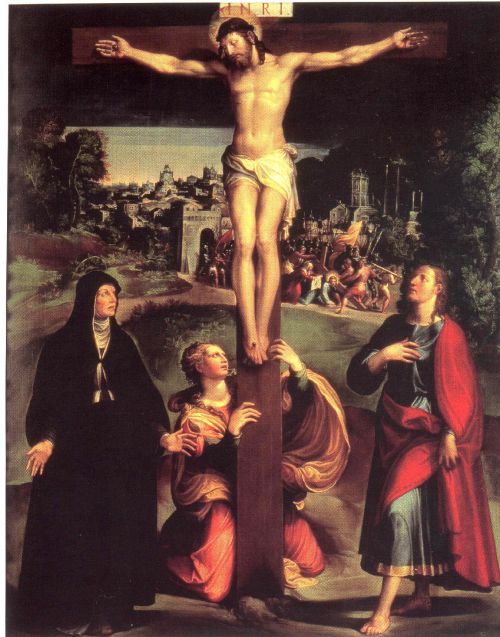
Am I cynical to see eroticism in this picture? (Many pictures show her naked too.) Note "St. John". slender and with long hair and no beard - a youth.
What about the love between Jesus and Lazarus? I studied the Bible for weeks on end and was surprised at how much there was in it, if you cared to look, and that included references to homosexuality. I am not talking about the literal sex-act, but of the often passionate relationships between men. This has always existed in the Church and many churchmen adore Jesus or God with a passion which is a little frightening.
I mention in my book "Looking for Mary M" the story of the centurian who asked Jesus to cure his "boy." When I asked a priest if the boy was either a son or a servant, he explained it's known in the Church that Roman soldiers, away from home, had a young man travel with them "for company away from home." This was not considered to be homosexuality at the time, nor by the Church today. Many modern churchmen are gay. (Whether they express it physically is none of our business.)
A passionate lover of Jesus was Vianney, the curé of Ars.
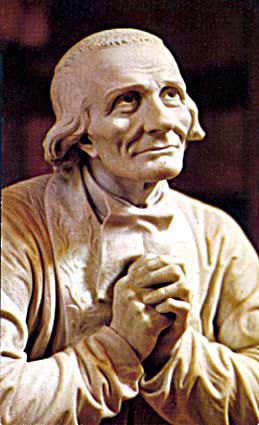
Vianney as a boy was always praying and having visions, it's said. He joined the army in 1809 but deserted, saying war was not the will of God. At his parish at Ars, he loved the church and founded a school for the boys. He was soon known to be a clairvoyant and his villagers say today; he already had a halo. He could levitate himself and rays of light emanated from him when he prayed. He talked with angels and told everyone they had a guardian angel who looked after them. He had visions, spirits appeared to him, and today modern French spiritualists regularly get messages from him. Pilgrims soon started going to his church and the village, full of religious fervour. Ars is now a complete pilgrims' centre and the curé's body, which has never decayed, is on show behind glass in the basilica.
His most famous prayer is "The Act of Love" in which he says; I love you God and my one desire is to love you until I die, up to the last moment of my life. I would like to die loving you, rather than live a single instant without loving you. . . I do not want Heaven, only the happiness of perfectly loving you. . . I fear Hell only because I would not have the sweet consolation of loving you . . give me the grace to suffer loving you and to die one day in loving you and sensing that I love you.
It reads like a love letter to me.
Gay people in the Church have told me it is assumed that Jesus and Lazarus were lovers. There's no doubt Lazarus adored Jesus, perhaps in the passionate spiritual/erotic way that seems to infuse Catholicism. But it was deeper than that. Let's start with the mysterious verses in St. Mark, 14, 50 - 52. The event was the arrest of Jesus. There was some fighting in which St. Peter cut off the ear of the High priest's slave. Then all the disciples left Jesus and ran away. A certain young man, dressed only in a linen cloth, was following Jesus. They tried to arrest him, but he ran away naked, leaving the cloth behind him.
If I am correct that young man was Lazarus, after the disciples ran away Lazarus stayed and tried to protect Jesus until he himself was forced to run for his life. But because of the "cloth" some assume a homosexual act was taking place, which seems utterly bizarre, in the circumstances of a pitched battle.
What is important is the bravery of Lazarus and the cowardice of the other disciples - Peter denied Jesus 3 times then he broke down and cried. Mark, 14, 72.
Another small part in St. John, 21 - 22 I found thought provoking; Peter, talking about the disciple Jesus loved, said; "Lord, what about this man?" Jesus answered him; "If I want him to live until I come, what is that to you?" then verse 24; He is the disciple who spoke of these things, the one who wrote them down; and we know that what he said is true. That disciple was Lazarus, the disciple that Jesus loved.
Why on earth would Peter say, what about this man? Jesus then more-or-less told him to mind his own business. The standard implication was, he was talking about somebody resurrected - strange, why should that suddenly come up then? It seems to me that Jesus's friendship with Lazarus was none of Peter's business.
But were they gay lovers? I researched on Wikipedia. It said; Of less significance is a suggested homoerotic interpretation of Christ's relationship with the Beloved Disciple, despite the absence of any scriptural evidence to this effect. That such an interpretation of a physical erotic relationship did exist as early as the sixteenth century is documented for example in the trial for blasphemy of Christopher Marlowe accused of claiming that "St. John the Evangelist was bedfellow to Christ and leaned always in his bosom, that he used him as the sinners of Sodoma". In accusing Marlowe of the "sinful nature" of homosexual acts, James I of England drew comparisons between his own erotic relationship with the Duke of Buckingham. Finally Calcagno, a citizen of Venice faced trial in 1550 for claiming that "St. John was Christ's catamite".
The discovery of fragments of the Secret Gospel of Mark seems to add fuel to the flames of the homosexuality debate. The Gospel no longer exists, but Morton Smith discovered a letter that makes reference to it. The actual words are; They came unto Bethany and a certain woman whose brother had died was there . . . Jesus being angered went off with her to the garden where the tomb was, and straightaway a great cry was heard from the tomb. And straightaway, going in where the youth was, he stretched forth his hand and raised him, seizing his hand. But the youth, looking upon him, loved him and began to beseech him that he might be with him. And going out of the tomb they came into the house of the youth, for he was rich. And after six days Jesus told him what to do and in the evening the youth came to him, wearing a linen cloth over his naked body. And he remained with him that night, for Jesus taught him the mystery of the Kingdom of God.
Of course the gay community emphasise these things but it seems again, something spiritual was going on. Catherine Mary told me; There is a letter found from a bishop at the time of the Nicene council, who had written to a monk in an Ethiopian monastery. It said that a paragraph in one of the gospels was to be taken out as it talks of a disciple (possibly John the beloved) spending the night with Jesus, and sleeping in the same bed with him. The bishop was worried that the public would think this amounted to a homosexual act. However during a modern Shamanic trance the Shaman and the client lie flat on their backs, in close contact with each other. The Shaman goes into a trance with the aid of ritual drumming, for the purpose of healing or finding something out. Because it was hot in Judea, being in close contact with someone all night would make you uncomfortable, and since the client must not move once the trance journey has begun in case of disturbing the journeying Shaman, it makes sense that neither man would have worn much clothing.
Who wrote St. John's Gospel?
Parts of it are very mystical and the stories of events often read like a play, with all the conversations repeated word for word. This Gospel must have been written by someone who was there. Who else but a person very close to Jesus?
The biblical scholar Bart Ehrman, has recently published a book called "Forged" which challenges the authenticity of the Gospels of Matthew, Mark and John, and disputes the assumption that the Apostle Peter wrote the Epistles of Peter or anything else. Unlike Paul, who wrote the Acts of the Apostles, Peter, a fisherman raised in rural Palestine, was almost certainly illiterate. So was the Apostle John, another fisherman. The fisherman John could have not written the Gospel bearing his name, says Ehrman.
St. John was also supposed to be the beloved disciple, the person who leant on Jesus's breast at the Last Supper and who attended the crucifixion. During the crucifixion Jesus recommended his mother to the beloved disciple's care, AND he suggested she became a mother to him. We already know there was no mother in the house at Bethany . . .
As all the disciples were in hiding by the time of the crucifixion, John the fisherman would not have been there. When Jesus was taken, Simon Peter and an unknown disciple followed Jesus, it says in St. John. The other disciple was well-known to the High Priest, so he went with Jesus into the courtyard of the high Priest's house. Peter stayed outside, warming his hands at a brazier and said that he did not know Jesus. John 18, 17 - 18. There is only, as far as we know, one disciple known to the High priests - Lazarus. It was a second attempt to save Jesus. And when he failed, Lazarus stayed by Jesus throughout the crucifixion.
The "St. John" pictured in crucifixion images and statues is often pictured as youth-like or slender, sometimes carrying a lily, which in the Church, signified purity or virginity. It was not John the fisherman, it was Lazarus.
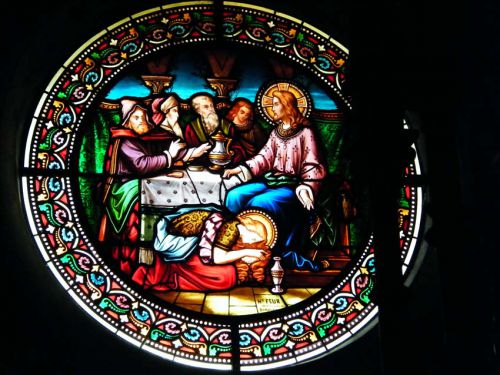
Many images of Lazarus show him as girl-like. In the church at Rennes-le-Château, above the altar, is a picture of Mary Magdalene washing Jesus's feet. This took place when Jesus was dining at the house of Simon the Pharisee, none of the disciples were present, so who is that girl-like person in the background? Well, Lazarus. He lived there.
Lazarus looked like his sister. Whatever we think today about pictures of a woman being at the Last supper, it was the same person who was leaning on Jesus's breast, the beloved disciple, and that person was meant to be Lazarus. Many pictures of the Last Supper show this.
Lazarus looked like his sister. When people first see this image, from one of the cards that were given away with chocolates in the 19th century in France, they say - "That's Mary Magdalene". But it was a representation of Lazarus.
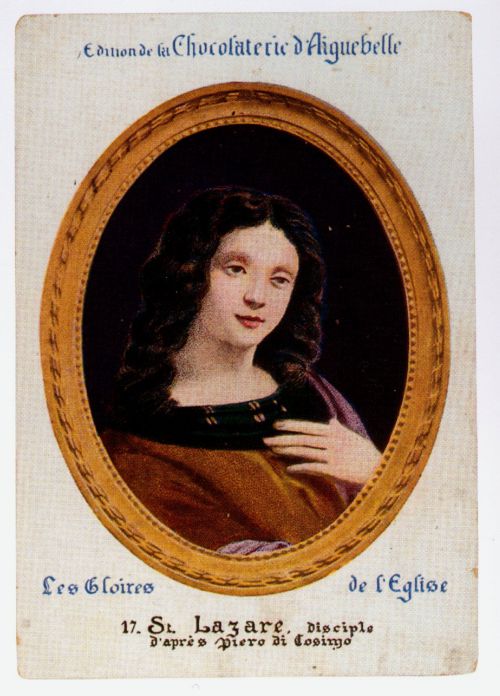
I have recently visited a cemetary in the Minervois village of Ventenac and saw the following Calvaire;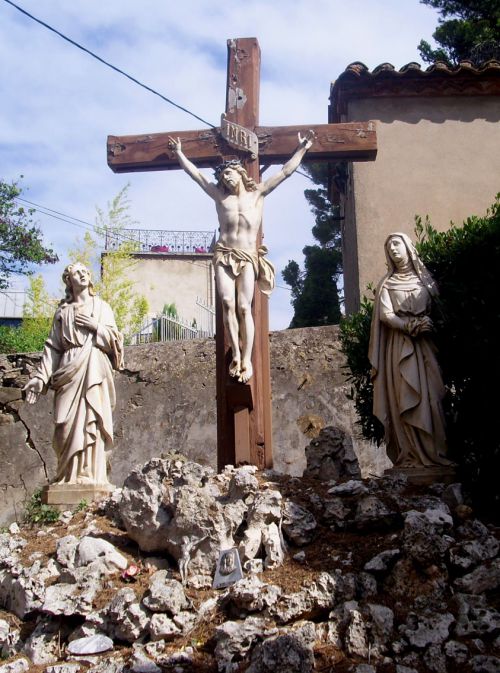
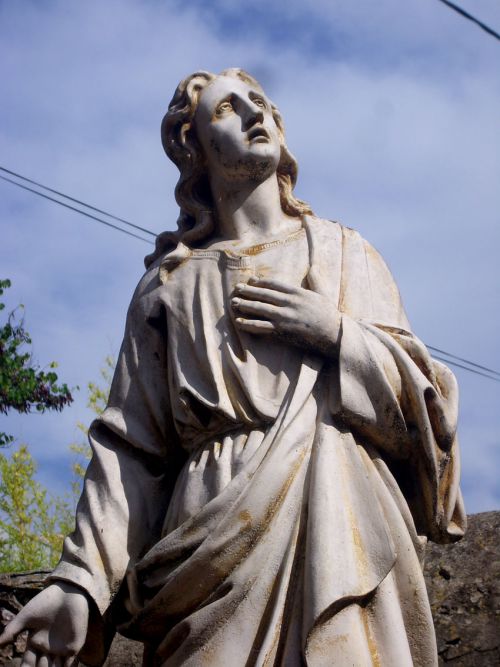
Who is the figure on the left? Usually we see Mary Magdalene and Mary, Jesus's mother, in a scene such as this, the two Mary's and Jesus. But the left-hand figure is breastless and has big hands; it is intended to be a man. Conventional Christians will tell you it is John the Evangelist. When Jesus choose his disciples he included two he called "The Sons of Thunder", John and James with a fishing business. It is unlikely John, a son of thunder, looked like a girl and wore his hair in this way. It was Lazarus, that some think should be named the Twelfth Disciple.
Meanwhile, the cemetary had a collection of Stations of the Cross, going anti-clockwise (as they do in the Church of Mary Magdalene at Rennes-le-Chateau.) Many of these at Ventenac did not show Mary Magdalene, which is very strange. Below is Station 14. This is the only image of laying Jesus in his tomb that I have seen that does not include Mary Magdalene. Here, it was "St. John" the disciple that Jesus loved, that he asked to care for his mother, that had his arms around jesus's mother when jesus was laid in his tomb.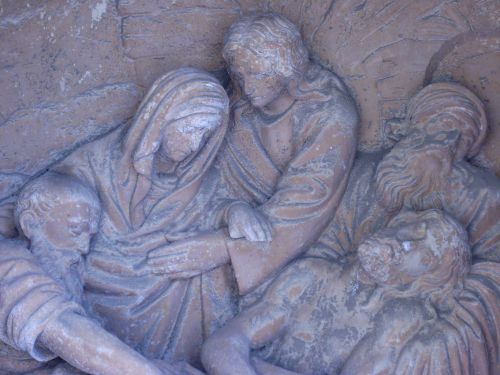
The Secrets of Revelations
Have you ever read the Book of Revelations? At the time a dream or vision or a revelation were considered more-or-less the same thing. The book is deep and mystical, and some say it encodes the details of the marriage of Mary Magdalene and Jesus and their children. If so, it must have been written by someone very close to them and some of the ideas in it I have heard spoken of by modern spiritualists who have never read the Bible. The Book of Revelations was written by Lazarus and describes his visions; just as today's spiritual people "see" the Biblical story and write about it.
It is obvious from both the Bible and from the Gnostic Gospels that the eternal four - Mary, Martha, Jesus and Lazarus - were highly educated and deeply interested in a more spiritual religion than Judaism. Their beliefs had eastern roots and have been recognised by many in today's spiritual community.
In my book Looking for Mary M, I analysed what we knew or the Bible said about which disciples went where after the crucifixion. Many think Mary Magdalene went to either Marseille or Stes. Maries de la Mer with various disciples with her. These stories are what the Church calls "tradition." But I believe Mary Magdalene and Jesus travelled separately from the rest, for security reasons, to the Rennes-le-Château region, (although not to Rennes-le-Château itself) while the others went to Provence.
"Tradition" says that Lazarus went to Marseille and became its first bishop (or church leader) and converted a number of the inhabitants to Christianity. It's said that under the first Christian persecution under Nero, around 66AD, Lazarus hid himself in a crypt, over which the Abbey of St.-Victor was constructed in the fifth century.
We first read of Lazarus in connection with the voyage that brought the saints to Gaul in an 11th century manuscript. A letter was written in 1040 by Pope Benedict IX on the occasion of the consecration of the new church of St.Victor of Marseille in which Lazarus is mentioned. But in his letter the pope wrote only of relics of St. Lazarus, merely calling him the saint who was raised again to life. He does not speak of him as having lived in Provence, or as having been Bishop of Marseilles.
It is only in the thirteenth century that the belief that Lazarus had come to Gaul with his two sisters and had been Bishop of Marseilles became widespread. The most ancient Provençal text alluding to the episcopacy of St. Lazarus is a passage in the "Otia imperialia" of Gervase of Tillbury (1212). In the crypt of St. Victor at Marseilles an epitaph of the of the fifth century has been discovered, which informs us that a bishop named Lazarus was buried there. To me, that sounds as though Lazarus was buried there, but when Constantine Roman Christianity was put into force they made a new epitaph, to put into force the idea that Lazarus came to Marseille and converted them all to Roman Christianity, not the early Christianity of Jesus. To me, that was false.
Another thing that convinces me, is how the name Lazarus started appearing then; people were named after him. He was popular. At the beginning of the twelfth century, perhaps through a confusion of names, it was believed at Autun (many miles to the north of Marseille) that the tomb of St. Lazarus was to be found in the cathedral dedicated to St. Nazarius. A search was made and remains were discovered, which were solemnly inspected and were considered to be those of him whom Christ raised from the dead. (I'm not convinced - read on.) Autun is situated on the pilgrim's route between Maçon and the great Mary Magdalene town of Vézelay.
Lazarus and Jesus at the Last Supper in Autun Cathedral.
St. Nazarius (not to be confused with St. Nazaire) was the abbot of the monastery of Lérins, off the coast of Provence, probably sometime during the reign of the Merovingian Clotaire II, 584-629. He successfully attacked the remnants of heathendom on the southern coast of France, overthrew a sanctuary of Venus near Cannes, and founded on its site a convent for women, which was destroyed by the Saracens in the eighth century. That's interesting, that pagan and heathen things still existed in the 7th century. They must have existed side by side with Christianity, for 600 years, for there's evidence that a Christian community lived in Marseille by 60AD.
Back to Marseille - the person, the Church tells us, in the crypt of St. Victor, was really Lazarus, the Bishop of Aix, who was consecrated at Marseilles about 407, and who, having had to abandon his seat in 411, (why would he have had to leave Aix, I wonder?) passed some time in Palestine, whence he returned to end his days in Marseille.
If we're confused now, how much worse it must have been for the ordinary believer who could not read or write! Meanwhile, what about the story that Lazarus buried his sister Mary Magdalene at Aix? She could not have lived until 407! (Her remains were later removed and squabbled about for centuries.)
I conclude then, that Lazarus played a much larger part in the whole drama of the New Testament much more than people suppose. He was a major player in the story and worthy of more study.
I am not the only person to make much of Lazarus. The story of the man brought back from the dead carries echos that reverberate down through the centuries . . .
As part of my research, I discovered, to my amazement, that some people think he came to Rennes-les-Bains! There's more about this in my book about Rennes-les-Bains. For further info, click here
What happened to everyone after the Crucifixion? For the last in this series of articles, click here.
Inscrivez-vous au site
Soyez prévenu par email des prochaines mises à jour
Rejoignez les 261 autres membres

